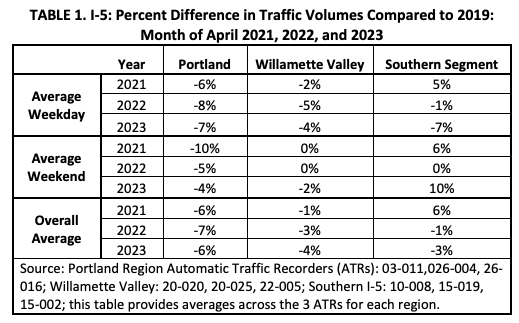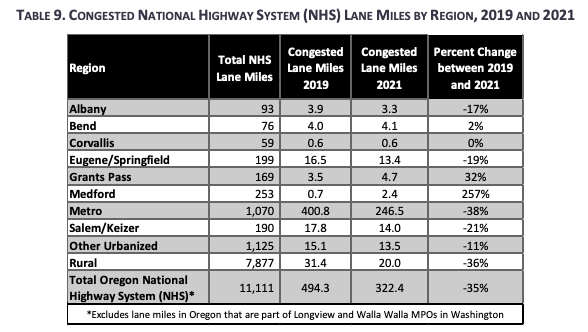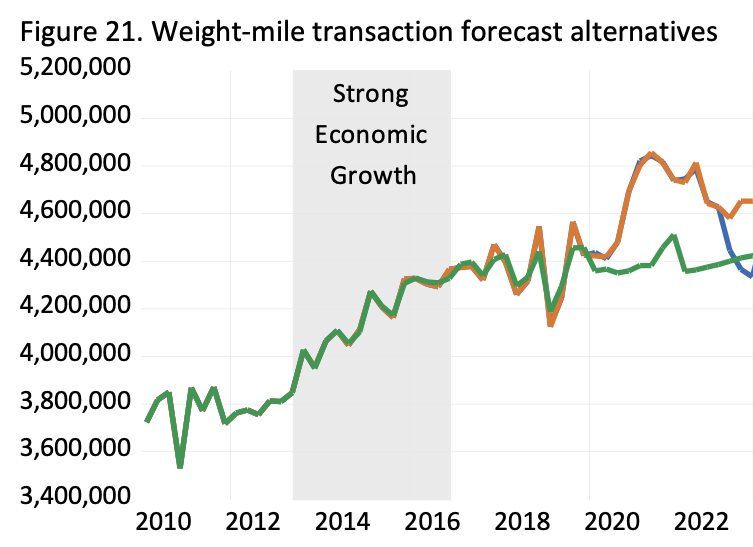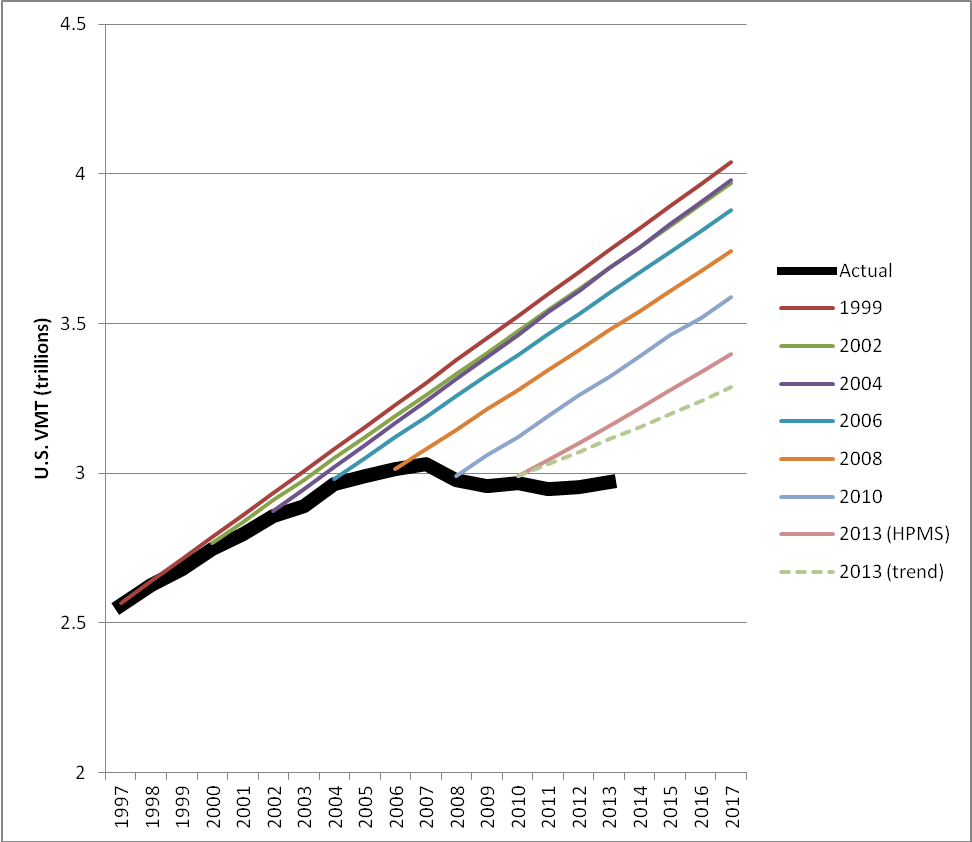A central message of the highway building sales pitch is that traffic is ever-growing and ever worsening, and that we have no choice but to throw more money at expanded capacity.
The Oregon Department of Transportation (ODOT) claims that traffic is every-rising, congestion is ever-worsening, and we’re always moving more and more trucks.
The reality, as revealed by ODOT’s own statistics is very different: Post-pandemic, traffic levels are lower than before, time lost to traffic congestion is down almost 40 percent, and fewer trucks are on Oregon’s roads.
This lower level of demand means we don’t need to squander billions on added capacity, as ODOT is proposing. Instead, measures to reduce or manage demand, like congestion pricing, could give us much faster travel times, at far lower cost.
For decades, highway advocates have described traffic as an ever-worsening menace. That messaging was very much on display in a recent legislative hearing in Oregon. at a meeting of the Joint Subcommittee on Transportation Planning. At its November 6, 2023 meeting, the Joint Subcommittee on Transportation Planning heard OregonDOT’s Brendan Finn, who presented a set of slides and made a number of key claims about future trends. Chief among them, the following:
- Traffic have already rebounded to pre-pandemic levels
- Congestion will only get worse
- Trucking will always increase
None of these claims is, in fact, true, according to data collected and reported by both ODOT and the federal government.
- Travel is consistently below pre-pandemic levels, and its flat as the economy expands
- Traffic on I-5 is down 7% below 2019 levels in 2023, and is lower than in 2021
- Traffic on I-84 is down 3% below 2019 levels in 2023, and is lower than in 2021
- Time lost to traffic congestion has declined by 40 percent in Portland
- Congested lanes miles are down from 400 in 2019 to 256 today
- Clark County vehicle hours of delay on SR 14, I-5 and I-205 are down 75% from 2019 in 2022
- Average commute times are down 10 percent
- Portland area commute times were 26.6 minutes in 2019
- They are now 24.4 minutes
- Trucking less than 20 years ago, and is declining
- Truck movements across the Columbia River are down nearly 20% from 2005
- Truck miles in Oregon are down 2.4% from 2019 levels, and down 3.9% for large trucks
- Truck miles are expected to decline further (HCAS) and are trending below pre-Covid levels, something the ODOT economist admits he can’t explain.
The reality is, now nearly three years after the peak of the pandemic’s effect on daily travel, travel has not returned to pre-Covid patterns or levels. Work at home has persisted. Even though the Oregon economy has more than fully recovered the jobs and income lost in the pandemic recession, travel levels and patterns are different and lower than prior to the pandemic. Work-at-home, at least a few days a week has become a “new normal” for a significant fraction of the Oregon workforce. Likewise, the Oregon economy (and national and global economies) have worked through the supply chain disruptions that plagued the transportation sector during, and just after the pandemic.
In short, claims that traffic is increasingly inexorably, that congestion is steadily getting worse, and we need more room for ever more trucks are flat out wrong.
ODOT’s fear-mongering predictions don’t really inform the policy debate about transportation. They don’t explain why we have transportation issues, and what can be done to solve them. They don’t shed any light, they only aim to generate heat. The reason for these dire forecasts about traffic, congestion and trucking is to serve as a sales pitch for giving ODOT billions of dollars for road building.
ODOT is proposing to undertake a series of incredibly expensive highway widening projects, even as there appears to be a fundamental shift in travel patterns than undercuts the rationale for these projects. ODOT is living in a world where Covid never happened, where work-from-home never happened, and where the long-term decline in per-capita driving in Oregon never happened. It is proposing to three giant projects each of which cost more than $1 billion per mile (the IBR 5 miles and $7.5 billion; the Rose Quarter 1.5 miles and $1.9 billion, and the Abernethy Bridge (.5 miles and $622 million). And it’s proposing to go deeply into debt to pay for each of these projects.
Traffic Levels are down, and staying down
What’s inarguable is that traffic levels are down in Oregon. The key question is whether these declines persist in the post-pandemic era? ODOT’s traffic counting staff have prepared a special report on exactly that subject which shows that traffic is not rebounding to pre-pandemic levels even three years after the height of the Covid shutdowns. ODOT’s staff analysis of travel trends shows that traffic volumes have gone down and stayed down in the post pandemic era. ODOT’s own traffic counting expert, Rebecca Knudsen reported in July 2023, that traffic levels on I-5 and I-84 in the Portland area were still below pre-pandemic levels in 2023, and were not increasing above 2022 or 2021 levels. In a document entitled Pandemic Impacts on Future Transportation Planning: Implications for Long Range Travel Forecasts Knudsen reported:

This pattern holds for Portland’s busiest highways. Current traffic volumes on I-84 in the Portland region are about 5% lower than 2019 overall, weekday volumes are about 3%; Traffic volumes on I-5 in the Portland region are currently about 6% lower than 2019 overall, weekday volumes are about 7% lower
Traffic congestion is down, and staying down.
ODOT periodically prepares a statewide “congestion report.” Its latest report, released earlier this year, confirms that congestion in Oregon isn’t growing. In fact, its declined significantly, even as the state economy grows rapidly following the pandemic.
Table 9 reports 2021 data presented in Figures 17 and 18, but also includes 2019 data to illustrate the difference pre- and post-pandemic. Statewide congested lane miles were 35% lower in 2021 than 2019. The largest decline was in the Willamette Valley. Portland Metro had a 38% decrease in congested lane miles, shifting from 400 congested lane miles in 2019 to 246 in 2021. (Page 27, emphasis added.)
ODOT has a “key performance measure” for statewide traffic performance that it provides routinely to the Oregon Transportation Commission, and which is supposed to guide policy. This measure shows that Oregon traffic congestion is down 38 percent in 2021 compared to pre-covid (2019 levels). ODOT is doing dramatically better than its goal. The number of congested lane miles statewide has declined from nearly 500 in 2019 to 322 in 2021.
Oregon’s Portland area data is confirmed by similar data gathered by the Washington State Department of Transportation. WSDOT’s Mobility Dashboard reports that traffic congestion is down sharply in Clark County with a persistent and sustained decline in congestion-related travel delays. According to WSDOT data, total vehicle hours of delay in Clark County’s three principal roadways are down more than 75 percent from pre-Covid (2019) levels.
Vehicle Delay, 1000s of hours (Clark County)
| I-5 | I-205 | SR 14 | All | |
| 2019 | 104,350 | 107,276 | 11,135 | 222,761 |
| 2022 | 21,542 | 28,170 | 2,409 | 52,121 |
| Change | -79% | -74% | -78% | -77% |
Sourrce: WSDOT, Mobility Dashboard
Commute times are down 10 percent from pre-Pandemic Levels
Lower levels of traffic and less congestion are showing up in reduced commute times for all workers. Census data confirm that the average commute trip in the Portland metropolitan area is about 2 minutes 20 seconds faster now than it was in 2019. The average Portland area commuter spends 2.2 minutes less time traveling to work each day according to the latest Census data, compared to the period before the pandemic. In 2019, the average resident spent 26.6 minutes traveling to work (one way); in 2021, the average resident spent 24.4 minutes. (Census Bureau, American Community Survey). These data actually understate total time savings, because they only represent travel times for workers who still regularly work outside the home; the commute data do not include the time savings for those who work at home.
Truck freight is lower than twenty years ago and is declining
Highway boosters love to assert that unless we expand highways, our economy will somehow grind to a halt. But the truth is, in the Internet era, and an economy shifting to smaller and lighter products and more services, and ever greater efficiency in production and distribution, truck freight movements have peaked and are declining. Oregon’s economic growth, in particular, has de-coupled from goods movement. ODOT’s testimony claims that truck freight in the Portland area will increase 57 percent in the next two decades, and implies we need to expand highway capacity to match.
ODOT actually has detailed data on truck freight movement in Oregon—data that wasn’t presented at the November 6 hearing. That data shows that statewide, truck freight is down 2.6 percent from pre-pandemic levels, and is decreasing, and is expected to decrease further. Oregon DOT’s corridor-level data show the number of trucks crossing the Columbia River today is down more than 20 percent from 2007 levels. ODOT’s just-released revenue forecasts shows a decline in freight movement, contrary to ODOT’s earlier forecasts that truck freight would continually increase. One reason that the recent Highway Cost Allocation Study (HCAS) shows trucks “overpaid” their share of highway expenses is that truck freight has grown much more slowly than ODOT projected.
ODOT’s statewide congestion report tracks truck mileage by weight class. The latest report concludes that truck VMT in Oregon is down below 2019 levels, and is down more sharply for large trucks.
| Truck Vehicle Miles 2019, and 2021 | |||
| Class | 2019 | 2022 | Change |
| Medium | 958 | 961 | 0.3% |
| Large | 2,213 | 2,126 | -3.9% |
| Total | 3,171 | 3,087 | -2.6% |
| Source: ODOT, 2022 Statewide Congestion Overview | |||
What is true statewide is also true in major corridors. One key corridor is I-5 and I-205 across the Columbia River. ODOT’s vehicle count data show that the number of trucks crossing the Columbia River is down almost almost 20 percent since 2006.
ODOT’s forecasts of truck freight have been consistently and wildly overstated
ODOT has long predicted steady increases in trucking. And it has long been wrong. In 2011, ODOT adopted the “Oregon Freight Plan”. It called for the volume of truck freight to increase 96 percent in 25 years, between 2010 and 2035. This amounts to an annual rate of increase of 2.2 percent per year. We are now more than half way through that period, and truck freight has gone down; between 2007 and 2022, truck freight volumes declined at an average annual rate of -0.2 percent per year.
ODOT’s latest financial reports concede that truck traffic is both below expectations, and is expected to decline further. Both ODOT’s biennial Highway Cost Allocation Study (HCAS) and its October 2023 Transportation Revenue Forecast point to a decline in truck travel in Oregon. ODOT’s own economist admits its modeling failed to accurately predict the decline in in trucking, which is now below its pre-Covid-forecast.
ODOT’s latest transportation revenue forecast reports a dramatic decline in weight-mile transactions. ODOT’s April 2023 forecast predicted that weight mile transactions would exceed 4.6 million (orange line), instead they’ve fallen to 4.3 million (blue line), and are now below the department’s pre-pandemic (2019) forecast (green line).
ODOT’s economist is at a loss to explain this decline:
Unfortunately, the prior forecast and our current forecast model do not adequately predict the drop we are currently seeing in the weight-mile transactions. This is concerning, as the forecast model has traditionally done a good job of predicting trucking activity. The last two quarters since the prior forecast have shown a significant drop, bringing us back in line with our pre-pandemic forecast.
(emphasis added)
This clear trend puts the lie to inflated forecasts claiming truck growth would always increase. In 2010, Metro predicted that truck freight in the Portland area would double by 2035. In fact, as we’ve seen truck freight has actually declined.
Why this matters
The alarmist warnings that an inexorable tide of traffic will condemn us to permanent traffic congestion is standard fare from highway boosters. The “predict and provide” approach is a way of rationalizing capacity increases as a way to avoid congestion. But added capacity has invariably simply generated more travel, more sprawling development patterns and more costly, congested roadways. The process is so well documented by study-after-study that its called the “Fundamental Law of Road Congestion.”
State highway departments invariably overstate future travel growth and congestion to sell highways. The State Smart Transportation Institute has cataloged this behavior, which has been going on for decades. No matter what the actual trend is in transportation, highway agencies predict “hockey stick” growth trends.
What recent Oregon data shows is that traffic increases aren’t inexorable or unavoidable. Since the pandemic, we’ve fundamentally changed our travel patterns. If ODOT officials were serious about reducing congestion, they’d be working to understand what about the past few years has enabled the reduction in traffic and congestion. Clearly, it has not been because of expanded capacity. Instead, the experience of the past few years shows the efficacy of managing demand. We saw big reductions in traffic congestion when more people started working at home—and those reductions and travel time savings have persisted. While initially it was due to the pandemic restrictions, workers and firms have embraced greater flexibility, and work from home is the new normal for a significant segment of the workforce. The underlying point is that measures that reduce or manage travel demand are the most effective means of reducing congestion.
What that should signal to ODOT and Oregon policy makers is the urgency of adopting a comprehensive congestion pricing system for the Portland area. Congestion pricing would directly manage demand. And critically, congestion pricing would enable us to greatly reduce congestion and improve travel times without spending billions on expanding highway capacity. ODOT’s own analysis of the I-5 Rose Quarter project showed that congestion pricing would be more effective in eliminating congestion and reducing traffic and pollution than spending $1.9 billion widening the roadway. In addition, congestion pricing makes urban freeways work better and carry more traffic: by keeping traffic flowing smoothly, pricing avoids traffic jams that actually reduce capacity.
Highway departments like ODOT view congestion data as a gimmick to sell roadway expansions, nothing more. When states actually chalk up big reductions in congestion (invariably, not because they’ve built more highways), there are crickets. OregonDOT and its peers are uninterested in learning from places that actually reduce congestion. When data provider Tom-Tom reported that Portland recorded the biggest decrease in congestion of any US metro area in 2019, ODOT said . . . nothing. At the time, we observed:
There’s a calculated asymmetry here: You can bet that if Portland had the biggest increase in congestion per Tom-Tom, it would be a front page story on the Oregonian, and a regularly repeated talking point by the Oregon Department of Transportation. If you’re a highway engineer, or traffic reporter, drawing attention to the terrible (and worsening) nature of congestion is a big part of the way you justify your existence. But good news, it seems, is no news. If there were any science or objectivity here, you’d think that the media would be celebrating this success (and praising the policies that led to it), and that the transportation agency would be looking to do more of whatever it was that made the congestion numbers improve.
The reason for this asymmetry, as we’ve suggested before at City Observatory, is that for all their bloviating to the contrary, highway departments really don’t care about reducing traffic congestion. Traffic congestion statistics and rankings are simply convenient public relations fodder for selling the next big highway construction project. If they were serious about reducing traffic congestion, these highway engineers would have looked seriously at the big declines in traffic congestion in the early part of this decade (thanks to higher gas prices), and the decline in traffic generated by tolling congested roads, like I-65 in Louisville, and moved aggressively to implement congestion pricing, which is the only strategy that’s been shown to be effective. But building things, not solving traffic problems, is really their priority.






